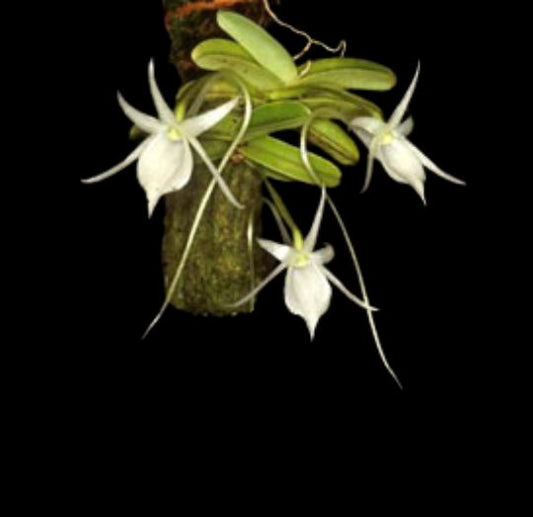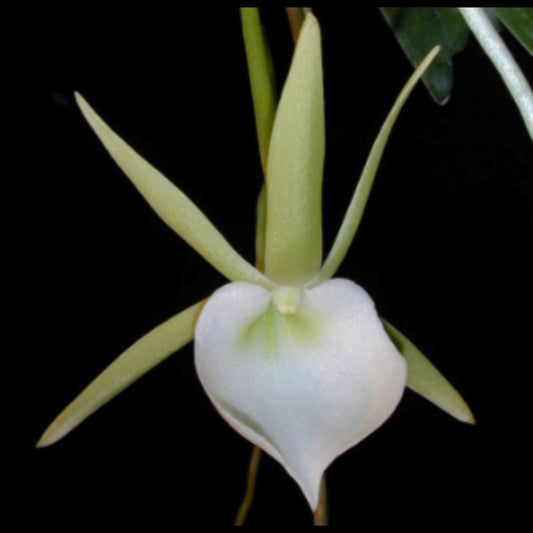La Foresta Orchids
Cattleya dormaniana
Cattleya dormaniana
Couldn't load pickup availability
Cattleya dormaniana is found in Brazil, where it grows epiphytic on trees in the humid cloud topped Organ Mountains at an altitude of 600 to 1000 meters above sea level.
It is a small to medium sized, cool to warm growing epiphyte with basally narrow, cylindrical, 20-28 cm long pseudobulbs carrying 2 ellipsoid, dark green, leathery, 15 cm long and 4 cm wide leaves. Thin, almost reed-like stems reach 12 or 15" tall. 3 inch flowers have olive-brown sepals and petals with distinctive lip, rose side lobes with purple veins and dark purple midlobe.
Very different! Rare and Unique!
Light:
Cattleya dormaniana loves bright sunlight and is able to tolerate direct sunlight (50000-70000 lux), acquiring a more saturated red-brown shade of leaves and pseudobulbs. Bright sunlight is one of the main prerequisites for flowering orchids of this species, and if lighting is insufficient (especially during the development of new shoots), then the blossom will simply not bloom, as new pseudobulbs grow underdeveloped, i.e. incapable of flowering. During the whole year, the duration of the light day should be at least 10 hours, ideally 16 hours.
Temperature:
This type of orchid refers to a moderately warm temperature regime, and throughout the year the plants are kept under the following conditions: Day temperature is not higher than 30 ° C; Night temperature at 15 ° C. For the successful cultivation at home, it is necessary that the night temperature of the content is always 8-15 ° C lower than the daytime temperature.
Humidity:
In the natural habitat, the relative humidity of the air rarely falls below 70%. In conditions of high humidity, it is necessary to regularly ventilate the room where the plants are kept, since wet, stale air is an ideal medium for the mass reproduction of various fungal and bacterial diseases.
Substrate, growing media and repotting:
Cattleya dormaniana is usually grow in pots and hanging lattice baskets, and placed on blocks. The substrate must be very well breathable, therefore, the mixture of the bark of coniferous trees with charcoal and sphagnum moss (30-35%) is best in its quality. When growing orchids on blocks to prevent rapid drying of the root system of the plant, it is recommended to make a small interlayer of moss between it and the block. Above the roots, you can also put live or dry sphagnum. When growing orchids in pots, heavy clay pots (unfired clay) proved to be the best ones. They not only contribute to a slow drying out of the substrate, but due to their severity they prevent the constant incidence of orchids, which, under the weight of their very long pseudobulbs, often fall to one side in lighter pots.
Repotting is desirable only when it is really necessary, for example, in cases of severe salinization or condensation of the substrate, at its critically high or low pH (the norm of 5.5 to 6.5) or , when the plant will grow very much and the pot will become too small for it (pseudobulbs will begin to hang from the edges of the pot). The best time for transplant is the time when new orchid sprouts reach a size of 5 cm and begin to build up their own roots.
Watering:
Watering this kind of orchids directly depends on the overall temperature of the content, the higher it is, the more often and abundant it is necessary to water. Plants growing on blocks, it is desirable to water daily in the morning, so that by evening their roots could dry out relatively well. When watering orchids in pots, it is necessary to remember that excess water during watering should flow freely out of the pot, as the stagnation of water both inside the pot and in its pallet can very quickly lead to rotting of the roots and the lower part of the plant. The substrate between the irrigations should dry relatively well, but do not dry out completely, i.e. is always in a slightly moistened, but not wet state.
Fertilizer:
During the new growth period, this type of orchid is fertilized every 2 weeks in 1/2 of the fertilizer concentration indicated on the package. In addition to the usual root top dressing, it is also recommended to produce a foliar dressing, when a very much diluted fertilizer is sprayed on the outer part of the plant. It is best to feed the orchid, alternating both these methods. The best fertilizer is fertilizer containing nitrogen, phosphorus and potassium in equal parts, for example, NPK = 3-3-3 or 8-8-8. If you do not have such a fertilizer, then at the beginning of the growing season (the emergence of new shoots), feed the orchid with a fertilizer with a high nitrogen content, and when the sprout reaches 1/2 of its normal growth - fertilizer with a higher content of phosphorus.
Rest period:
Cattleya dormaniana has 2 period of rest. The first period of rest begins immediately after the maturation of new pseudobulbs and is expressed in the fact that the orchid is put on the brightest possible (for autumn) places and contain a few drier and colder than usual, and do not fertilize. The total temperature should be about 18 ° C in the daytime and not higher than 14-15 ° C at night. Watering the orchids is desirable to coordinate in such a way that the substrate does not just dry very well, but it was completely dry for about 10-14 days, when growing plants on blocks, they are slightly sprayed once a week to avoid deadly drying of the spray. With the advent of peduncles, the rest period ends and the watering of the orchid resumes in the usual volume.
Immediately after flowering and until the appearance of new shoots in the spring, the orchid undergoes another (winter) rest period, which the plant needs as a rest after flowering. In terms of its conditions, it is identical to the first, with the only difference being that the overall temperature of the contents can be the same both in daytime and at night. For example, 18 ° C and night and day, etc. The lack of rest after flowering is fraught with the gradual degeneration of the orchid, every year its pseudobulbs fade, they form fewer and fewer flowers until a complete refusal of flowering occurs.
This is a near to blooming size in a 4” clay pot newly repotted about 1 to 2 years to bloom, grown from seed, limited
































